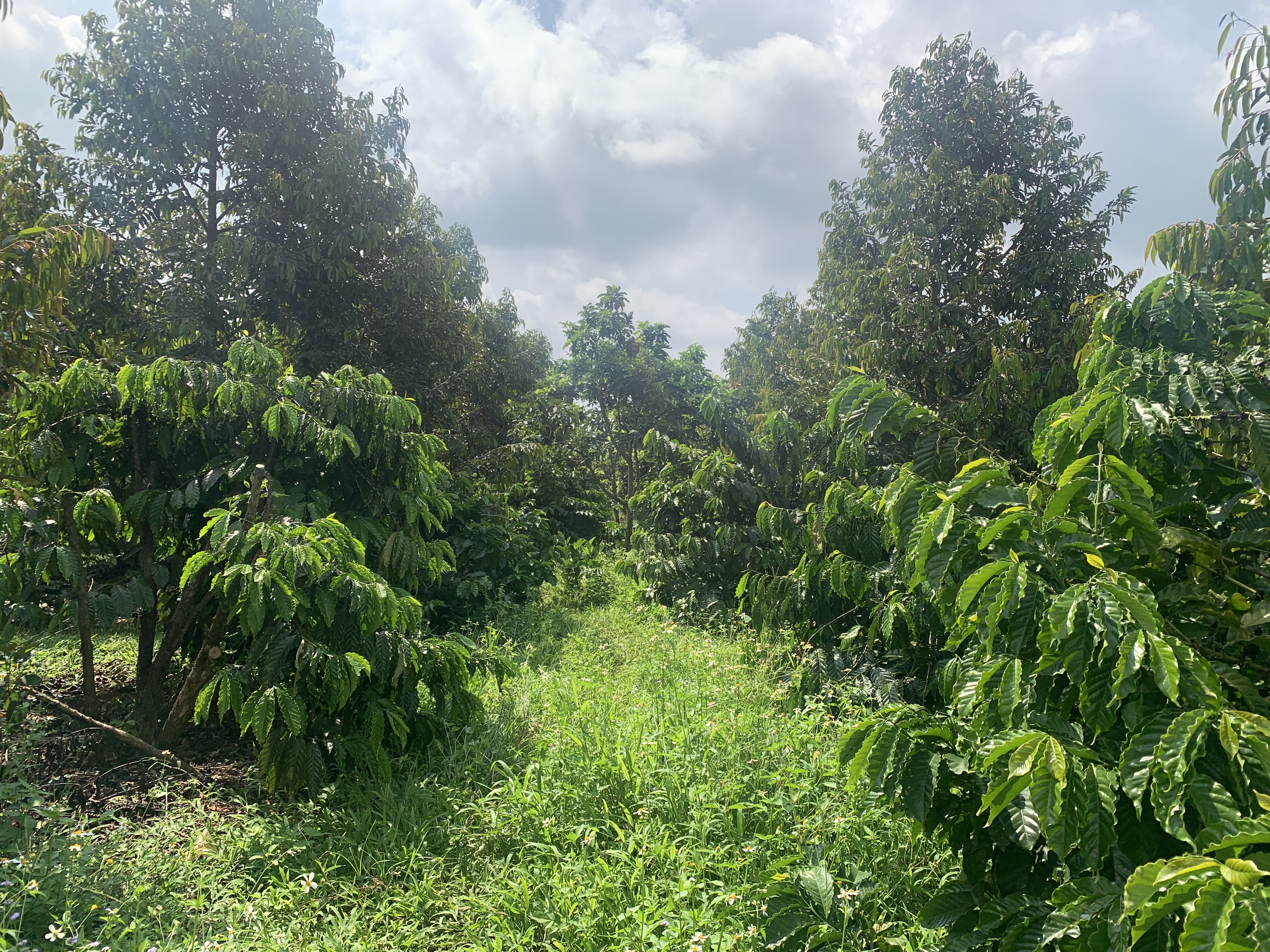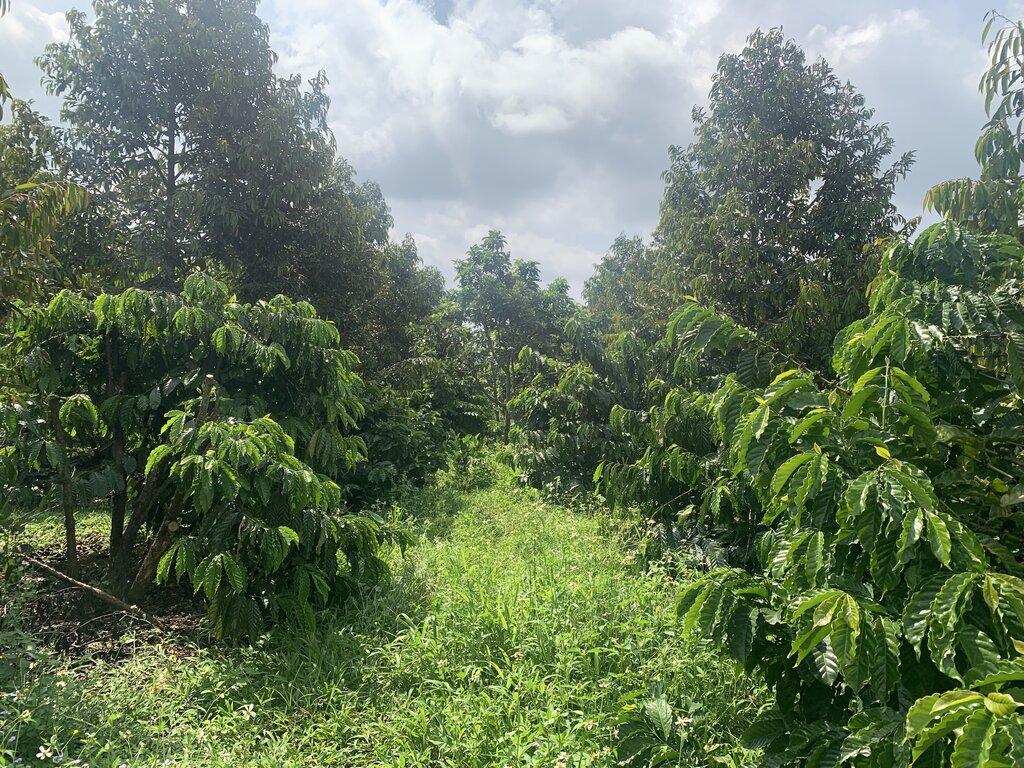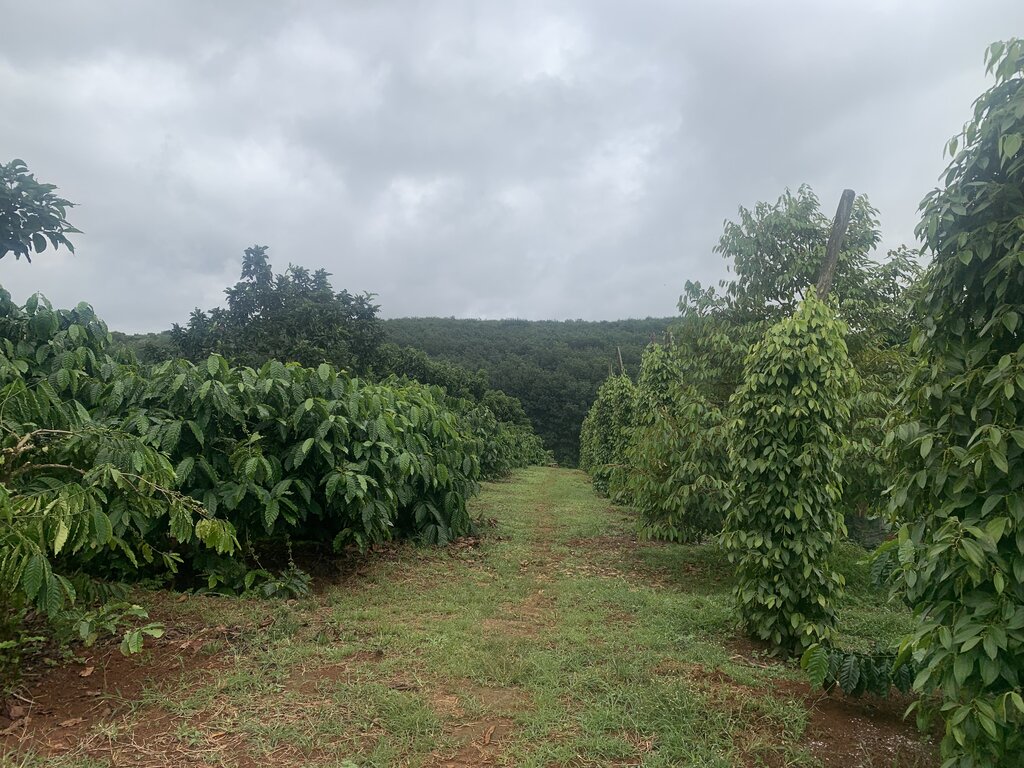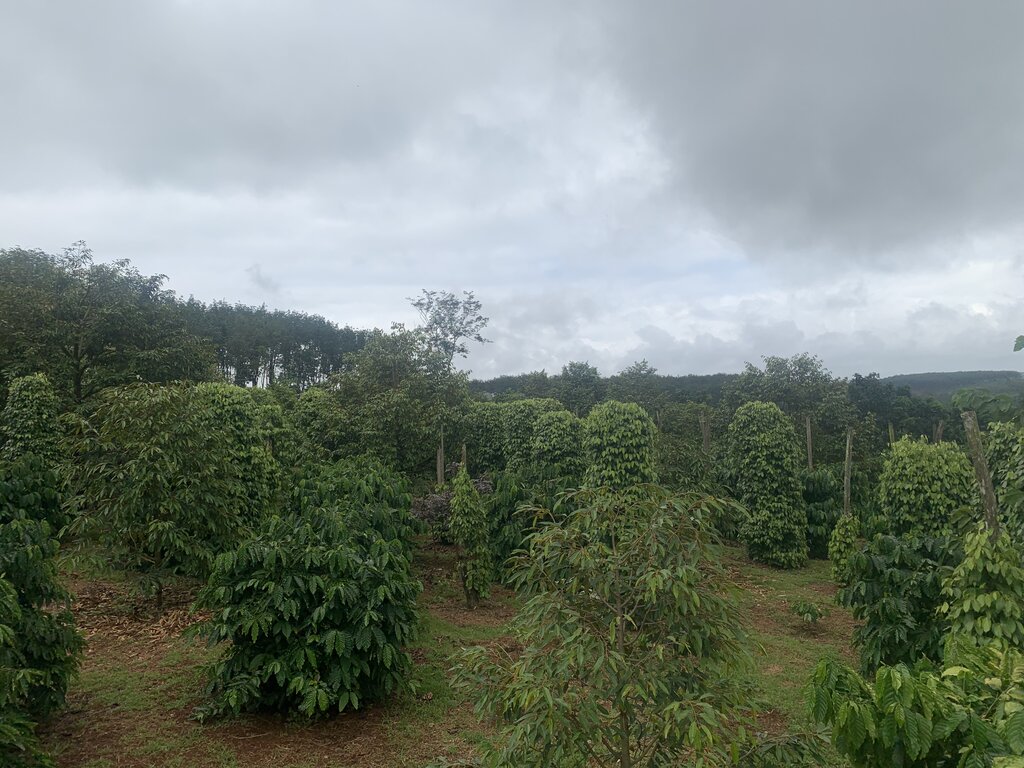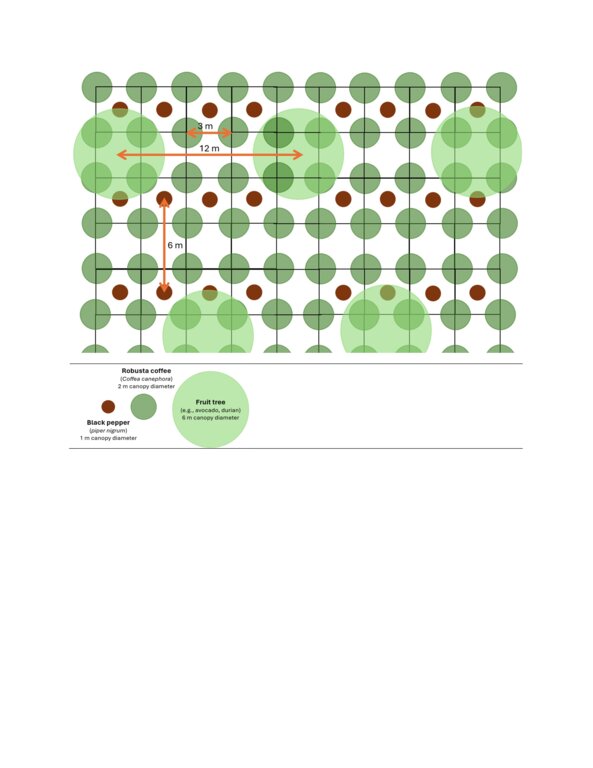Multi-storey intercropping with coffee and fruit trees [Viet Nam]
- Creation:
- Update:
- Compiler: Carlos Gil Picon
- Editor: Eric Rahn
- Reviewers: William Critchley, Rima Mekdaschi Studer
Mô hình trồng xen cây ăn quả trong vườn cà phê
technologies_7387 - Viet Nam
View sections
Expand all Collapse all1. General information
1.2 Contact details of resource persons and institutions involved in the assessment and documentation of the Technology
Key resource person(s)
co-compiler:
Ha Tuan
Nguyen University and CIAT
Viet Nam
Name of project which facilitated the documentation/ evaluation of the Technology (if relevant)
Land Use Based Mitigation for Resilient Climate Pathways (LANDMARC)Name of the institution(s) which facilitated the documentation/ evaluation of the Technology (if relevant)
Alliance Bioversity and International Center for Tropical Agriculture -Vietnam (Alliance Bioversity-CIAT)1.3 Conditions regarding the use of data documented through WOCAT
The compiler and key resource person(s) accept the conditions regarding the use of data documented through WOCAT:
Yes
1.4 Declaration on sustainability of the described Technology
Is the Technology described here problematic with regard to land degradation, so that it cannot be declared a sustainable land management technology?
No
2. Description of the SLM Technology
2.1 Short description of the Technology
Definition of the Technology:
Robusta coffee in the Central Highlands of Vietnam is intercropped with pepper vines and fruit trees thus increasing the total planting density. This leads to higher land equivalent ratios compared to monocropping, thereby increasing land use efficiency, profitability, soil protection and resilience.
2.2 Detailed description of the Technology
Description:
Robusta coffee in the Central Highlands of Vietnam is intercropped with pepper vines and fruit trees, increasing the total planting density. This leads to higher land equivalent ratios (LER) compared to monocropping, thereby increasing land use efficiency, profitability and resilience. The increased plot-level biomass stock also confers better soil protection, and more biomass is returned to the soil through prunings and natural litter formation.
There are a variety of multi-storey intercropping designs based on coffee (Coffea canephora), black pepper (Piper nigrum), avocado (Persea americana), durian (Durio zibethinus) and macadamia (Macadamia integrifolia). An example of a recommended intercropping design is coffee with pepper vines (supported by living poles of Ceiba pentandra, Cassia siamea, Paulownia spp. etc) and fruit trees at densities of 887 coffee bushes, 336 pepper vines, 28 avocado trees and 28 durian trees per hectare (D’Haeze 2022; Rigal et al. 2023). Agronomic practices such as irrigation and nutrient management need to be adapted to this system. For example, water demand by coffee in the shade of fruit trees is less than in monocropping systems. Other practices can be combined, such as the use of cover crops (e.g., Crotalaria) planted between the other crops to avoid bare land.
This technology is increasingly applied in Dak Lak, Gia Lai, Lam Dong and Dak Nong in the Central Highlands of Vietnam, primarily by the Kinh farmers, while ethnic minorities currently rely more frequently on monocropped coffee systems.
The main purpose of this diversified mixed cropping system it to increase land use efficiency as well as productive, climatic and economic resilience. Price volatility is a huge challenge for farmers, particularly with perennial cropping systems where crop changes as response to economic signals is costly and risky due to time-lag effects.
Quality planting material (e.g., use of scion avocado cultivar 034 for grafting), water-saving irrigation systems, and organic and mineral fertilizers are required alongside a careful planting design that minimizes potential competition between associated crops. For example, the Ministry of Agriculture and Rural Development (MARD) provides guidelines (Decision No. 3702, 2018) for designing intercropping systems based on coffee.
The main benefit is economic resilience to volatile prices of perennial commodity crops. Given that perennial crops cannot be easily substituted with other crops that have better prices, diversification of cropping systems is key to economic resilience. Furthermore, land use efficiency is increased and thereby more crops can be produced using less area. Tree-level yields remain the same as in monocropping systems, however, after certain years of fruit tree growth (e.g., avocado) there is a potential of coffee tree-level yield decline due to shade effects. It also helps to manage production costs when crops need to be rejuvenated or replanted. Furthermore, carbon stocks in aboveground biomass are increased compared to monocropping systems. This increase in aboveground carbon stocks leads to higher biomass input to the soil due to fresh litter (prunings) and senescent litter (natural).
Land users choose this intercropping model to diversify their income on the same unit of land. This reduces the risks associated with unpredictable price fluctuations. They also note that this system improves resource use efficiency, requiring less fertilizers and irrigation compared to the monocropping systems.
2.3 Photos of the Technology
2.5 Country/ region/ locations where the Technology has been applied and which are covered by this assessment
Country:
Viet Nam
Region/ State/ Province:
Dak Nong
Further specification of location:
Hung Binh commune
Specify the spread of the Technology:
- evenly spread over an area
If precise area is not known, indicate approximate area covered:
- 100-1,000 km2
Is/are the technology site(s) located in a permanently protected area?
No
Map
×2.6 Date of implementation
If precise year is not known, indicate approximate date:
- 10-50 years ago
2.7 Introduction of the Technology
Specify how the Technology was introduced:
- through land users' innovation
- through projects/ external interventions
Comments (type of project, etc.):
Next to land user's own innovation, the technology is also being introduced and promoted by the department of crop production of the Ministry of Agriculture and Rural Development (MARD) and the extension systems after refinement through research institutions under MARD such as WASI in the Central Highlands. Furthermore, it is also being introduced by Universities and companies.
3. Classification of the SLM Technology
3.1 Main purpose(s) of the Technology
- reduce, prevent, restore land degradation
- adapt to climate change/ extremes and its impacts
- create beneficial economic impact
- Reduce economic risks due to price volatility
3.2 Current land use type(s) where the Technology is applied
Land use mixed within the same land unit:
Yes
Specify mixed land use (crops/ grazing/ trees):
- Agroforestry

Cropland
Specify:
this questionnaire refers to a variety of crops with different growing season characteristics
Is intercropping practiced?
Yes
If yes, specify which crops are intercropped:
Coffee (Coffea canephora), black pepper (Peper nigrum) poles (Ceiba pentandra; Cassia Siamea; Paulownia spp.), avocado (Persea americana, durian (Durio zibethinus), macadamia (Macadamia integrifolia).
Is crop rotation practiced?
No
3.3 Has land use changed due to the implementation of the Technology?
Has land use changed due to the implementation of the Technology?
- No (Continue with question 3.4)
Land use mixed within the same land unit:
No

Cropland
- Perennial (non-woody) cropping
- Tree and shrub cropping
Is intercropping practiced?
No
Is crop rotation practiced?
No
3.4 Water supply
Water supply for the land on which the Technology is applied:
- mixed rainfed-irrigated
3.5 SLM group to which the Technology belongs
- agroforestry
- improved ground/ vegetation cover
3.6 SLM measures comprising the Technology

agronomic measures
- A2: Organic matter/ soil fertility

management measures
- M1: Change of land use type
Comments:
Composting using agricultural residues, and a change from mono-cropping to agroforestry
3.7 Main types of land degradation addressed by the Technology

soil erosion by water
- Wt: loss of topsoil/ surface erosion

water degradation
- Ha: aridification
Comments:
Intercropping in combination with cover crops, Intercropping and cover cropping helps increase soil moisture.
3.8 Prevention, reduction, or restoration of land degradation
Specify the goal of the Technology with regard to land degradation:
- prevent land degradation
Comments:
While the main goal of land users in adopting this technology is to diversify income sources and reduce risks related to price volatility, it also reduces soil degradation by leaving less soil bare compared with the interrows of monocropped coffee and increases biomass input to the soil.
4. Technical specifications, implementation activities, inputs, and costs
4.1 Technical drawing of the Technology
Technical specifications (related to technical drawing):
Planting density of coffee (Coffea canephora) is 3m by 3m. Coffee trees typically grow to a height of 1.5 to 2m, with a canopy width of around 2m. For the associated tree species, the densities depend on the species and the number of species. For example, black pepper (piper nigrum) can be intercropped at a density of 9m x 9m on living tree poles such as Cassia Siamea, Leucena Leucocephala, etc. Pepper vines grow up to 5 m in height and can also be planted at higher density (e.g. 6 x 3m) at the expense of fruit trees. Avocado (Persea americana), Durian (Durio zibethinus), and macadamia (Macadamia integrifolia) can be intercropped at 12m x 12m. These fruit trees share similar sizes and shapes and grow to a height ranging from 5-10m, with a canopy spanning from 6-8m. The study by Rigal et al. (2023) provide a great overview of the diversity of intercropping / agroforestry designs with different species mixtures and planting densities: Rigal C., Duong T., Vo C., Bon L.V., Hoang q.T., Chau T.M.L. (2023) Transitioning from monoculture to mixed cropping systems: The case of coffee, pepper, and fruit trees in Vietnam. Ecological Economics 214:107980.
Author:
Own illustration based on Rigal et al. (2023) and MARD: Good Agricultural Practices for Robusta Coffee Production.
4.2 General information regarding the calculation of inputs and costs
Specify how costs and inputs were calculated:
- per Technology area
Indicate size and area unit:
1 hectare
Specify currency used for cost calculations:
- USD
Indicate average wage cost of hired labour per day:
12
4.3 Establishment activities
| Activity | Timing (season) | |
|---|---|---|
| 1. | Nursery with grafted material | Dry season |
| 2. | Soil preparation | April or May; before the onset of the rainy season |
| 3. | Planting | rainy season |
| 4. | Fertilizer application | rainy season |
| 5. | irrigation | dry season |
Comments:
Establishment will take 3 years until first coffee harvests. Harvests of other fruit trees will start later.
4.4 Costs and inputs needed for establishment
If you are unable to break down the costs in the table above, give an estimation of the total costs of establishing the Technology:
7000.0
Comments:
This estimate is based on a system of 887 coffee plants, 336 pepper vines, 28 avocado trees (based on grafting with improved variety) and 28 durian trees.
4.5 Maintenance/ recurrent activities
| Activity | Timing/ frequency | |
|---|---|---|
| 1. | Creating a basin around the tree base for keeping water during irrigation phase | |
| 2. | Application of fertilizers and pesticides | |
| 3. | Irrigation | |
| 4. | Weeding and pruning | |
| 5. | Guiding the black pepper vines onto the poles and trimming branches of living poles | |
| 6. | Tying durian fruits to branches by plastic ropes for support | |
| 7. | Sanitation after each harvest |
4.6 Costs and inputs needed for maintenance/ recurrent activities (per year)
If you are unable to break down the costs in the table above, give an estimation of the total costs of maintaining the Technology:
4000.0
Comments:
The maintenance costs refer to the establishment stage (first 3 years) until first harvest and are based on a system of 887 coffee plants, 336 pepper vines, 28 avocado trees (based on grafting with improved variety) and 28 durian trees.
4.7 Most important factors affecting the costs
Describe the most determinate factors affecting the costs:
production inputs (fertilizers, pesticides), and hired labor. Initial establishment cost of irrigation systems is also costly.
5. Natural and human environment
5.1 Climate
Annual rainfall
- < 250 mm
- 251-500 mm
- 501-750 mm
- 751-1,000 mm
- 1,001-1,500 mm
- 1,501-2,000 mm
- 2,001-3,000 mm
- 3,001-4,000 mm
- > 4,000 mm
Agro-climatic zone
- humid
5.2 Topography
Slopes on average:
- flat (0-2%)
- gentle (3-5%)
- moderate (6-10%)
- rolling (11-15%)
- hilly (16-30%)
- steep (31-60%)
- very steep (>60%)
Landforms:
- plateau/plains
- ridges
- mountain slopes
- hill slopes
- footslopes
- valley floors
Altitudinal zone:
- 0-100 m a.s.l.
- 101-500 m a.s.l.
- 501-1,000 m a.s.l.
- 1,001-1,500 m a.s.l.
- 1,501-2,000 m a.s.l.
- 2,001-2,500 m a.s.l.
- 2,501-3,000 m a.s.l.
- 3,001-4,000 m a.s.l.
- > 4,000 m a.s.l.
Indicate if the Technology is specifically applied in:
- not relevant
5.3 Soils
Soil depth on average:
- very shallow (0-20 cm)
- shallow (21-50 cm)
- moderately deep (51-80 cm)
- deep (81-120 cm)
- very deep (> 120 cm)
Soil texture (topsoil):
- medium (loamy, silty)
Soil texture (> 20 cm below surface):
- medium (loamy, silty)
5.4 Water availability and quality
Ground water table:
> 50 m
Availability of surface water:
poor/ none
Water quality (untreated):
good drinking water
Is water salinity a problem?
No
Is flooding of the area occurring?
No
5.5 Biodiversity
Species diversity:
- medium
Habitat diversity:
- medium
Comments and further specifications on biodiversity:
Considering that it is relative to other sites of the region, I would classify it as medium. Forests have highest diversity, and the mixed coffee agroforestry systems have medium diversity. While other agricultural land has low diversity.
5.6 Characteristics of land users applying the Technology
Sedentary or nomadic:
- Sedentary
Market orientation of production system:
- commercial/ market
Off-farm income:
- 10-50% of all income
Relative level of wealth:
- average
Individuals or groups:
- individual/ household
Level of mechanization:
- manual work
Gender:
- women
- men
Age of land users:
- middle-aged
- elderly
5.7 Average area of land used by land users applying the Technology
- < 0.5 ha
- 0.5-1 ha
- 1-2 ha
- 2-5 ha
- 5-15 ha
- 15-50 ha
- 50-100 ha
- 100-500 ha
- 500-1,000 ha
- 1,000-10,000 ha
- > 10,000 ha
Is this considered small-, medium- or large-scale (referring to local context)?
- medium-scale
5.8 Land ownership, land use rights, and water use rights
Land ownership:
- individual, not titled
- individual, titled
Land use rights:
- individual
Water use rights:
- open access (unorganized)
5.9 Access to services and infrastructure
health:
- poor
- moderate
- good
education:
- poor
- moderate
- good
technical assistance:
- poor
- moderate
- good
employment (e.g. off-farm):
- poor
- moderate
- good
markets:
- poor
- moderate
- good
energy:
- poor
- moderate
- good
roads and transport:
- poor
- moderate
- good
drinking water and sanitation:
- poor
- moderate
- good
financial services:
- poor
- moderate
- good
6. Impacts and concluding statements
6.1 On-site impacts the Technology has shown
Socio-economic impacts
Production
crop production
Comments/ specify:
Profitability and risk mitigation has increased, which is the main reason why there is adoption at scale.
risk of production failure
Comments/ specify:
Profitability and risk mitigation has increased, which is the main reason why there is adoption at scale.
product diversity
Comments/ specify:
Product diversity could still be increased.
Income and costs
farm income
Comments/ specify:
Costs increase initially, but over time the benefits outweigh the costs. In some cases, external financial support is needed to adopt the practice.
diversity of income sources
Comments/ specify:
Income sources increase from 1 (i.e., coffee) to several (e.g., pepper, avocado, durian).
workload
Comments/ specify:
Work efficiency increases when intercropping, compared to having the crops separately on different fields as monocrops. Nonetheless, the workload is larger when simply comparing to 1 coffee monocropping field.
Ecological impacts
Soil
soil moisture
Comments/ specify:
Soil moisture increases due to the change in microclimate from shade trees and cover crops.
soil cover
Comments/ specify:
Soil cover increases through the use of selective weeding or cover crops. Current practices often leave their soils bare exposing them to erosion during heavy rainfall.
Biodiversity: vegetation, animals
Vegetation cover
Comments/ specify:
Vegetation cover increases, which is particularly beneficial for soil conservation.
biomass/ above ground C
Comments/ specify:
Above- and belowground C increases, however there is potential to integrate additional trees with higher biomass values.
plant diversity
Comments/ specify:
Plant diversity increases. However there is potential to further increase the diversity on the farm.
Climate and disaster risk reduction
drought impacts
Comments/ specify:
Microclimate benefits from shade trees reduce the impact of droughts.
Specify assessment of on-site impacts (measurements):
Combination of literature studies (e.g., Rigal et al. 2023; D'haeze 2022) and own (yet) unpublished observations.
- Rigal C., Duong T., Vo C., Bon L.V., Hoang q.T., Chau T.M.L. (2023)
Transitioning from Monoculture to Mixed Cropping Systems: The Case of Coffee, Pepper, and Fruit Trees in Vietnam,
Ecological Economics 214:107980
- D’haeze, D. (2022). Optimizing water use in the central highlands of Viet Nam: Focus on
the Robusta coffee sector. Hanoi, Viet Nam: IUCN and Gland, Switzerland.
6.2 Off-site impacts the Technology has shown
buffering/ filtering capacity
Comments/ specify:
Increased soil cover improves soil properties and filtering capacity.
Specify assessment of off-site impacts (measurements):
Literature based and own observations.
For example:
-Cannavo, P., Sansoulet, J., Harmand, J.-M., Siles, P., Dreyer, E., & Vaast, P. (2011). Agroforestry associating coffee and Inga densiflora results in complementarity for water uptake and decreases deep drainage in Costa Rica. Agriculture, Ecosystems & Environment, 140(1–2), 1–13. https://doi.org/10.1016/j.agee.2010.11.005
- Chatterjee, N., Nair, P. K. R., Nair, V. D., Bhattacharjee, A., Filho, E. D. M. V., Muschler, R. G., & Noponen, M. R. A. (2019). Do Coffee Agroforestry Systems Always Improve Soil Carbon Stocks Deeper in the Soil?—A Case Study from Turrialba, Costa Rica. Forests, 11(1), 49. https://doi.org/10.3390/f11010049
6.3 Exposure and sensitivity of the Technology to gradual climate change and climate-related extremes/ disasters (as perceived by land users)
Gradual climate change
Gradual climate change
| Season | increase or decrease | How does the Technology cope with it? | |
|---|---|---|---|
| annual temperature | increase | moderately | |
| seasonal temperature | summer | increase | moderately |
| seasonal rainfall | dry season | increase | well |
Climate-related extremes (disasters)
Climatological disasters
| How does the Technology cope with it? | |
|---|---|
| drought | moderately |
Hydrological disasters
| How does the Technology cope with it? | |
|---|---|
| landslide | moderately |
Biological disasters
| How does the Technology cope with it? | |
|---|---|
| insect/ worm infestation | well |
Comments:
The practice is considered an important climate change adaptation strategy, however, more research is needed to provide the the required evidence.
6.4 Cost-benefit analysis
How do the benefits compare with the establishment costs (from land users’ perspective)?
Short-term returns:
negative
Long-term returns:
positive
How do the benefits compare with the maintenance/ recurrent costs (from land users' perspective)?
Short-term returns:
negative
Long-term returns:
positive
Comments:
It can take between 5 to 10 years until the relative advantage is achieved, as the associated crops first need to reach their productive stage. Hence, investment costs will be higher until the associated crops can be harvested.
6.5 Adoption of the Technology
- 11-50%
Of all those who have adopted the Technology, how many did so spontaneously, i.e. without receiving any material incentives/ payments?
- 51-90%
6.6 Adaptation
Has the Technology been modified recently to adapt to changing conditions?
Yes
If yes, indicate to which changing conditions it was adapted:
- changing markets
Specify adaptation of the Technology (design, material/ species, etc.):
Farmers are very sensitive to market signals. For example, the price of durian has increased, so farmers plant more durian. Earlier the same happened with pepper.
6.7 Strengths/ advantages/ opportunities of the Technology
| Strengths/ advantages/ opportunities in the land user’s view |
|---|
| The main advantage is the increased profitability and market/climate risk management. |
| There are additional benefits such as improvement in soil ecology to manage soil-borne pests and diseases and reduced irrigation need for coffee. |
| Interest from coffee buyers in sustainable production systems provides another incentive to change practices. |
| Strengths/ advantages/ opportunities in the compiler’s or other key resource person’s view |
|---|
| More resilient livelihoods |
| More diversified landscapes |
| Increased carbon storage capacity |
6.8 Weaknesses/ disadvantages/ risks of the Technology and ways of overcoming them
| Weaknesses/ disadvantages/ risks in the land user’s view | How can they be overcome? |
|---|---|
| Initial investment costs can be high for some smallholder farmers | External financial support is needed through market mechanisms. |
| There continues to be a need to adapt agronomic practices to the new system design. This knowledge is not yet fully available. | Research activities to provide the required evidence and enable the development of guidelines. |
| Weaknesses/ disadvantages/ risks in the compiler’s or other key resource person’s view | How can they be overcome? |
|---|---|
| There continues to be a need to adapt agronomic practices to the new system design. This knowledge is not yet fully available. | Research activities to provide the required evidence and enable the development of guidelines. |
7. References and links
7.1 Methods/ sources of information
- field visits, field surveys
- interviews with land users
7.3 Links to relevant online information
Title/ description:
Rigal et al. (2023) Transitioning from monoculture to mixed cropping systems: the case of coffee, pepper, and fruit trees in Vietnam
URL:
https://doi.org/10.1016/j.ecolecon.2023.107980
Title/ description:
Dave D'Haeze (2022) Optimizing water use in the Central Highlands of Viet Nam. Focus on the Robusta coffee sector
URL:
https://iucn.org/sites/default/files/content/documents/2022/bridge_ch_coffee_transformation_final_february_2022-_revised_2_ddh_for_publication.pdf
Title/ description:
MARD (2003) Good Agricultural Practices for Robusta Coffee Production.
Links and modules
Expand all Collapse allLinks
No links
Modules
No modules


